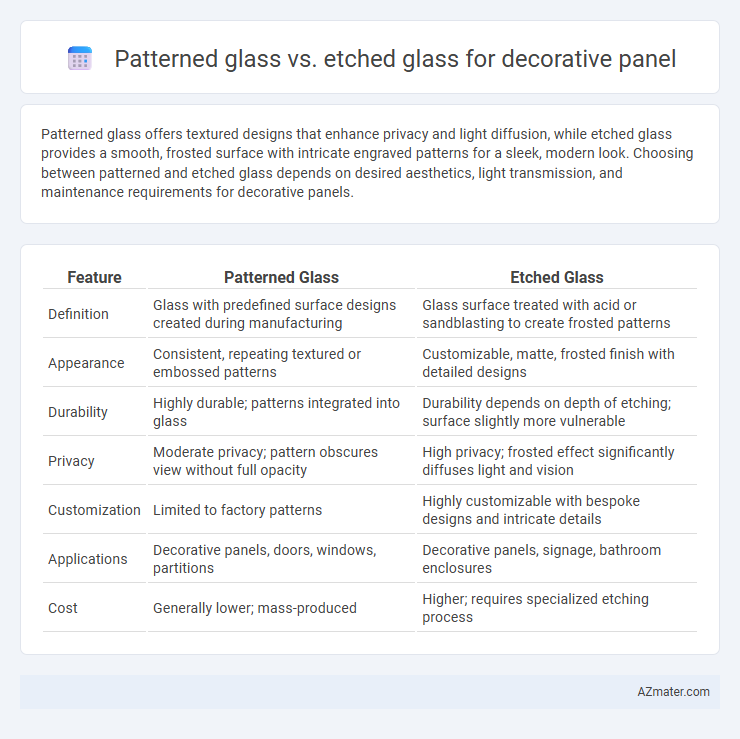Patterned glass offers textured designs that enhance privacy and light diffusion, while etched glass provides a smooth, frosted surface with intricate engraved patterns for a sleek, modern look. Choosing between patterned and etched glass depends on desired aesthetics, light transmission, and maintenance requirements for decorative panels.
Table of Comparison
| Feature | Patterned Glass | Etched Glass |
|---|---|---|
| Definition | Glass with predefined surface designs created during manufacturing | Glass surface treated with acid or sandblasting to create frosted patterns |
| Appearance | Consistent, repeating textured or embossed patterns | Customizable, matte, frosted finish with detailed designs |
| Durability | Highly durable; patterns integrated into glass | Durability depends on depth of etching; surface slightly more vulnerable |
| Privacy | Moderate privacy; pattern obscures view without full opacity | High privacy; frosted effect significantly diffuses light and vision |
| Customization | Limited to factory patterns | Highly customizable with bespoke designs and intricate details |
| Applications | Decorative panels, doors, windows, partitions | Decorative panels, signage, bathroom enclosures |
| Cost | Generally lower; mass-produced | Higher; requires specialized etching process |
Introduction to Patterned vs Etched Glass
Patterned glass features textured surfaces created by rolling molten glass over engraved rollers, providing a variety of repetitive designs that enhance privacy while allowing light transmission. Etched glass is created through acid or abrasive techniques that produce permanent, smooth, matte designs by removing surface layers, enabling more customized and artistic patterns. Both types offer unique aesthetic and functional advantages for decorative panels, with patterned glass emphasizing texture and light diffusion, and etched glass offering intricate, refined visuals.
Understanding Patterned Glass
Patterned glass features embossed or rolled designs that create textured surfaces, enhancing privacy while allowing light to pass through, making it ideal for decorative panels. Its versatile patterns range from geometric shapes to abstract motifs, providing both aesthetic appeal and functional benefits in interior spaces. Unlike etched glass, which involves acid or sandblasting to create permanent matte designs, patterned glass offers a three-dimensional texture that can mask fingerprints and smudges more effectively.
What is Etched Glass?
Etched glass is created through an acid or abrasive process that removes a thin layer of the glass surface to produce a frosted, textured design that enhances privacy while allowing light to pass through. This technique offers more intricate and customizable patterns compared to patterned glass, which is typically molded with repetitive textures during manufacturing. Etched glass panels are ideal for decorative applications where subtle elegance and artistic detail are desired, such as office partitions, shower enclosures, and feature walls.
Design Possibilities and Aesthetic Appeal
Patterned glass offers intricate, repetitive designs that enhance privacy while allowing light diffusion, making it ideal for bold, textured decorative panels. Etched glass features customized, frosted images or motifs created by acid or sandblasting, providing a sophisticated, artistic aesthetic with a smooth matte finish. Both options elevate interior design, with patterned glass emphasizing tactile dimension and etched glass showcasing detailed, refined visuals.
Light Transmission and Privacy
Patterned glass features textured surfaces that diffuse light while maintaining moderate transparency, making it ideal for spaces requiring both natural illumination and partial privacy. Etched glass provides a frosted, opaque finish that significantly reduces light transmission but enhances privacy by obscuring visibility. Both are popular choices for decorative panels, with patterned glass offering a balance of brightness and privacy, whereas etched glass prioritizes seclusion over light passage.
Durability and Maintenance
Patterned glass offers high durability with its textured surface that resists scratches and fingerprints, making it ideal for decorative panels requiring low maintenance. Etched glass, created by sandblasting or acid etching, provides a matte finish but can be more prone to surface wear and requires regular cleaning to maintain its appearance. Both options enhance aesthetic appeal, but patterned glass generally offers superior longevity and easier upkeep in high-traffic or frequently handled applications.
Cost Comparison
Patterned glass typically costs less than etched glass due to simpler manufacturing processes involving rolled or pressed designs, making it a budget-friendly option for decorative panels. Etched glass requires more labor-intensive techniques such as acid etching or sandblasting, resulting in higher production costs and a premium price point. Choosing between patterned and etched glass depends on the desired aesthetic and project budget, with patterned glass offering affordability without sacrificing visual appeal.
Applications in Decorative Panels
Patterned glass offers textured designs ideal for diffusing light and enhancing privacy in decorative panels used in office partitions and shower enclosures. Etched glass provides a smooth, frosted appearance perfect for custom graphics or logos, frequently utilized in corporate settings and upscale interior decor. Both options improve aesthetic appeal while serving functional purposes in residential and commercial decorative panel applications.
Environmental Impact and Sustainability
Patterned glass typically requires fewer chemical treatments and less energy-intensive processes compared to etched glass, making it a more environmentally friendly option for decorative panels. Etched glass involves acidic or abrasive techniques that can generate hazardous waste and increase the carbon footprint during production. Choosing patterned glass supports sustainability goals by reducing harmful emissions and promoting resource-efficient manufacturing.
Choosing the Right Glass for Your Project
Patterned glass offers intricate, raised designs that provide texture and privacy, making it ideal for decorative panels in residential or commercial spaces requiring both aesthetics and function. Etched glass features smooth, frosted surfaces achieved through acid or sandblasting, delivering a subtle, elegant look suitable for modern interiors seeking diffuse light and privacy. Selecting the right glass depends on the desired visual effect, level of opacity, and maintenance requirements specific to your project's style and environmental conditions.

Infographic: Patterned glass vs Etched glass for Decorative panel
 azmater.com
azmater.com